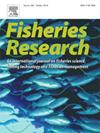Seasonal morphometry and extractive pressure on polychaetes Hediste diversicolor and Marphysa sanguinea from Southwest Spain
IF 2.2
2区 农林科学
Q2 FISHERIES
引用次数: 0
Abstract
This study aimed to investigate the morphometry, length-weight relationships and extractive activity on two commercially significant polychaete species, Hediste diversicolor and Marphysa sanguinea in the Bay of Cadiz (Southwest Spain). Due to measurement challenges with these fragile organisms, jaw length was introduced as a key morphological measure in the length-weight relationships. Specimens were collected monthly throughout 2019, totaling 942 H. diversicolor and 404 M. sanguinea. Eight morphometric variables were measured, including total length, width, right and left jaw lengths, and various weight metrics. Regression models and changepoint analyses were used to assess morphometric relationships and seasonal variations. Extraction rates were estimated through direct observation of shellfish harvesters. Results showed that the inclusion of jaw length improved the accuracy of length-weight relationships, particularly for H. diversicolor. Both species exhibited negative allometric growth patterns, with seasonal variations in length-weight regressions. Significant extraction rates were observed, averaging 0.85 polychaetes per minute per shellfisher. The findings highlight the need for implementing management regulations, such as control of illegal harvesters, to ensure the sustainability of these species. This study provides essential data for informed decision-making in the conservation and management of these species in the region.
求助全文
约1分钟内获得全文
求助全文
来源期刊

Fisheries Research
农林科学-渔业
CiteScore
4.50
自引率
16.70%
发文量
294
审稿时长
15 weeks
期刊介绍:
This journal provides an international forum for the publication of papers in the areas of fisheries science, fishing technology, fisheries management and relevant socio-economics. The scope covers fisheries in salt, brackish and freshwater systems, and all aspects of associated ecology, environmental aspects of fisheries, and economics. Both theoretical and practical papers are acceptable, including laboratory and field experimental studies relevant to fisheries. Papers on the conservation of exploitable living resources are welcome. Review and Viewpoint articles are also published. As the specified areas inevitably impinge on and interrelate with each other, the approach of the journal is multidisciplinary, and authors are encouraged to emphasise the relevance of their own work to that of other disciplines. The journal is intended for fisheries scientists, biological oceanographers, gear technologists, economists, managers, administrators, policy makers and legislators.
 求助内容:
求助内容: 应助结果提醒方式:
应助结果提醒方式:


